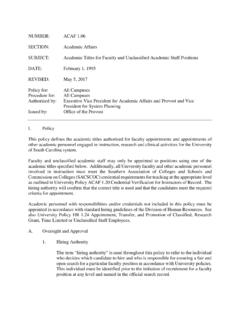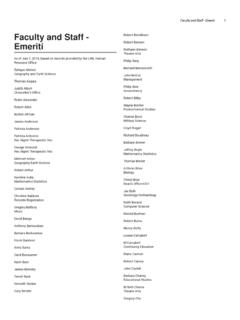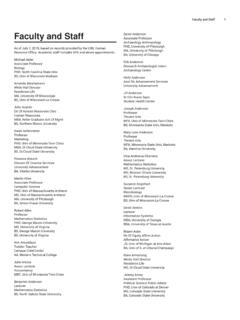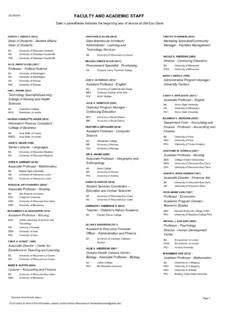Transcription of Academic Administrator Leadership Styles and the Impact on ...
1 DOI: Journal of Leadership Education Summer 2014 34 Academic Administrator Leadership Styles and the Impact on faculty Job Satisfaction Justin Bateh, Assistant Professor of Business Florida State College at Jacksonville Wilton Heyliger, faculty , Business Administration Walden University Abstract This article examines the Impact of three Leadership Styles as a predictor of job satisfaction in a state university system. The Multifactor Leadership Questionnaire was used to identify the Leadership style of an Administrator as perceived by faculty members. Spector s Job Satisfaction Survey was used to assess a faculty member s level of job satisfaction.
2 The population consisted of 567 full-time faculty members, and 104 participants completed the survey. The results of logistic regression analysis revealed that (a) faculty members who identified transformational Leadership as dominant had increased job satisfaction, (b) faculty members who identified transactional Leadership as dominant had increased job satisfaction, and (c) faculty members who identified passive/avoidant Leadership as dominant had decreased job satisfaction. Demographics did not appear to predict satisfaction. Using this model, Academic leaders can take further action by refining their Leadership Styles on the basis of their faculty members indicated preferences.
3 The study results may contribute to social change at the departmental level by making Academic administrators aware of effective Leadership models that promote higher job satisfaction among faculty in universities. Introduction An organization s success depends on hiring and retaining satisfied employees (Cordeiro, 2010). faculty members play a vital role in the success of higher education institutions (Cordeiro, 2010). Through increased job satisfaction, greater employee retention helps colleges and universities achieve adequate faculty allocations (Froeschle & Sinkford, 2009). faculty job satisfaction and its relationship to retention in higher education are business-related issues, as a 5% increase in retention can lead to a 10% reduction in costs (Wong & Heng, 2009).
4 A similar increase in retention can further result in substantial productivity increases, to as much as 65% (Wong & Heng, 2009). 35 Journal of Leadership Education Summer 2014 Seventy-seven percent of employees in the United States have reported dissatisfaction with their jobs (Mardanov, Heischmidt, & Henson, 2008), and as DeConinck (2009) reported, job dissatisfaction eventually leads to voluntary turnover. The estimated salary premium required to replace one dissatisfied faculty member totals $57,000 (Finch et al., 2010). Since the State University System of Florida launched the New Florida Initiative, increased enrollments created the need for faculty members to assume administrative positions with Leadership responsibilities (Austin, 2012).
5 Some new administrators lack knowledge of how their Leadership style impacts faculty member job satisfaction (Lawrence & Bell, 2012). Universities in the United States experience high levels of faculty turnover (Klein & Takeda-Tinker, 2009). Most universities use faculty search committees that screen initial applications and, simultaneously, represent a massive investment of financial resources and faculty time (Cordeiro, 2010). The ability to hire and retain effective faculty remains a serious problem for higher education institutions (Wong & Heng, 2009). Job satisfaction plays a vital role in retaining faculty (Wong & Heng, 2009).
6 Colleges and universities experience lack of trained leaders for a number of reasons. As members of the baby boomer population retire, which creates a smaller workforce population, colleges draw new faculty administration members from a smaller pool of qualified applicants (Campbell, Syed, & Morris, 2010; Finch, Allen, & Weeks, 2010). Apart from the fact that hiring and retaining talented college faculty administrators may be extremely costly, and time consuming (Green, Alejandro, & Brown, 2009), generational differences play one of the major roles in faculty members continued dissatisfaction with leaders (Salahuddin, 2010).
7 The difficulties seen in the State University System of Florida bring these generational challenges to the surface. As the State University System of Florida is in the process of launching the New Florida Initiative, enrollments likely will increase across all universities within the system. This increased enrollment may result in rapid transformation of Leadership positions because of the need for a larger teaching faculty (Lawrence & Bell, 2012). This may push administrators to assume new Leadership responsibilities, and many leaders may not understand the importance of encouraging an open and productive conversation with faculty members (Lawrence & Bell, 2012).
8 Administrators selected for the new Leadership positions may have little understanding of how their Leadership decisions affect faculty members satisfaction with their job (Klein & Takeda-Tinker, 2009). As faculty leaders retire and transition, filling vacant faculty positions will also require much evaluation and thought. Research into a state university within the State University System of Florida, through the present study, may expose differences between the motivations and desires of the Academic leaders and faculty members. Research Purpose and Question The purpose of this quantitative, correlational study was to examine the relationship between perceived Academic Administrator Leadership Styles and job satisfaction of full-time faculty members.
9 The design of the study was correlational and nonexperimental. The independent variables were the transformational, transactional, and passive/avoidant Leadership Styles of Academic administrators as evaluated by faculty members. The dependent variable was job satisfaction of full-time faculty members. The population consisted of 567 full-time faculty 36 Journal of Leadership Education Summer 2014 members within the university, including professors, associate professors, assistant professors, instructors, and lecturers. The minimum number of participants required for significant study results was 81 as determined by a power analysis, and 104 participated.
10 The location of the study was an institution within the State University System of Florida, which had experienced increased demand for new leaders since the launch of the New Florida Initiative. Conceptual Framework and Hypotheses We evaluated the relationship between Academic Administrator Leadership Styles and faculty job satisfaction within an institution in the State University System of Florida. We evaluated the relationship between Academic Administrator Leadership Styles using the Multifactor Leadership Questionnaire (Bass, Avolio, Jung & Berson, 2012) and faculty job satisfaction using the Job Satisfaction Survey (Spector, 2011) within an institution in the State University System of Florida.









